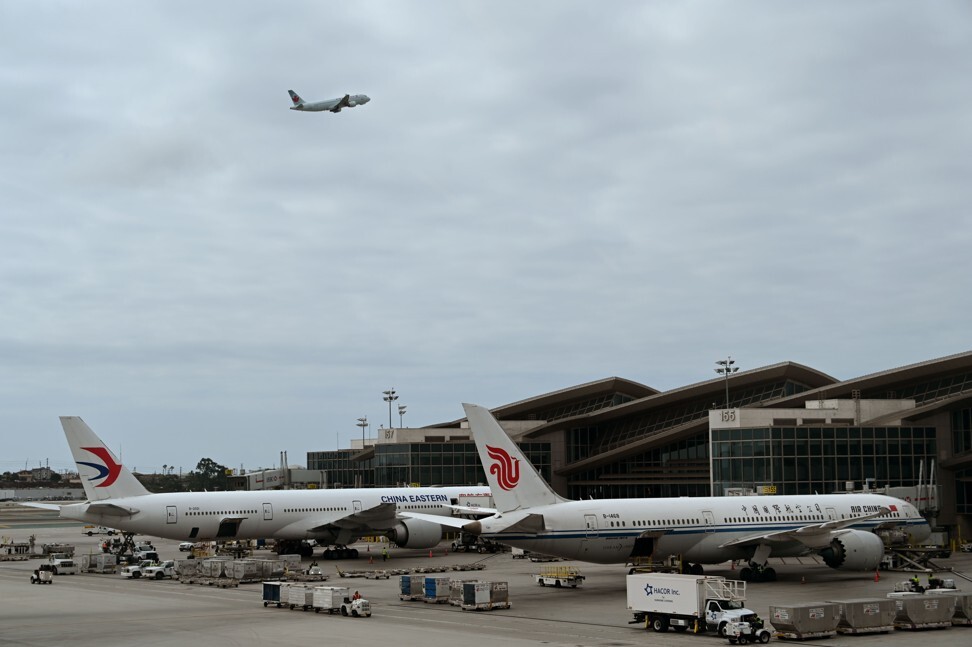
US and China regulators reopen some air routes, letting some carriers to fly again as they back off from aviation standoff
- Delta Air Lines and United Airlines Holdings were each allowed to mount two weekly services to China, as the Civil Aviation Authority of China (CAAC) yielded to US lobbying
- The US Department of Transportation responded overnight by doubling the number of Chinese flights to the US to four a week

Aviation regulators of the United States and China have stepped back from their stand-off to allow each other’s airlines to add flights in the lucrative US-China route, giving stranded carriers the fighting chance to survive the worst slump in the global travel industry.
Delta Air Lines and United Airlines Holdings, the two largest US carriers by market capitalisation, were each allowed to mount two weekly services to China, as the Civil Aviation Authority of China (CAAC) gave in to US lobbying, Caixin reported without saying where it got its information. The US Department of Transportation responded overnight by doubling the number of Chinese flights to the US to four a week.
“As the Chinese government allows more flights by US carriers, we will reciprocate,” the American regulator said, adding that it would continue to pursue the full restoration of passenger air travel between the two nations.
The reciprocal moves reflect the horse trading that the world’s two largest economies have to engage in, as they each struggle to restore growth amid the slump created by the coronavirus pandemic. Global airlines, facing an industry-wide loss of US$314 billion in 2020 passenger revenue, need up to US$200 billion to survive the pandemic, according to a March 18 estimate by the International Air Travel Association (Iata), the industry guild. The US government has set aside a US$29 billion fund for the four largest American carriers including Delta and United to help them survive.

“The focus of bilateral aviation policies had shifted to the US reluctance to open up demand because of perceived imbalances in the [reciprocal air rights], from the pre-coronavirus dialogue which mainly concerned procedures to further open up air rights and market share between the US and China,” said Yu Zhanfu, a partner at the consultancy Roland Berger in Shanghai. “In the short term there would not be big frictions on air right, but minor frictions may continue.”
With the new relaxation, US airlines would be able to restore at least some of the services that they had suspended since the coronavirus outbreak was first reported in the Hubei provincial capital of Wuhan. Delta would be able to start flying to Shanghai from Seattle and Detroit. Chicago-based United has yet to pick its routes out of the previous dozen daily services to Beijing, Chengdu, Shanghai and Hong Kong.
On the Chinese side, the four weekly services will be shared among four carriers. Air China, the nation’s flag carrier, will fly every Sunday to Los Angeles from Beijing. China Southern Airlines, the largest fleet operator, will fly to Los Angeles from its Guangzhou hub in southern China, while China Eastern Airlines will fly every Tuesday to New York from its Shanghai hub. Xiamen Airlines, based in Fujian province, will fly to Los Angeles every Sunday from Xiamen.
Chinese aviation stocks rose in Hong Kong and Shanghai following the detente. Air China rose by as much as 3.3 per cent in Hong Kong and gained 2.1 per cent in Shanghai. China Southern advanced by as much as 4 per cent in Hong Kong, rising 1.8 per cent in Shanghai. China Eastern’s H shares increased 3.9 per cent in Hong Kong, while its A shares rose 2.8 per cent.
Earlier this month, Beijing relaxed the restrictions and gave US carriers access to some of the most lucrative routes in global aviation, following an overnight statement by Washington to stop all Chinese flights. Starting on June 8, all 95 foreign carriers that were excluded from a March 26 restriction on inbound international flights can fly once a week to a Chinese city capable of handling overseas arrivals, the Civil Aviation Administration of China said.
“China and the US are attempting to reduce the dispute between each other,” said Li Hanming, an independent aviation consultant and founder of Li & Li consultancy based in Chicago. As China, the first major economy to go into the coronavirus lockdown, and the first to emerge, is close to get its economy back on its feet, carriers from both the US and China want as much access to routes as possible, he said.